
Hazmat emergency response plans are required by law for any company, business, or institution that works with hazardous materials. Operators and personnel at facilities that manage hazardous materials must know what to do and how to react in the event that an accident occurs. At a minimum, plans should outline a set of procedures, protocols, and responsibilities to ensure a correct response to any incidents that involve hazardous materials.
The list of hazardous materials is lengthy, but suffice it to say that it includes various chemicals, gases, flammable liquids, radioactive substances, and other dangerous materials that pose a significant risk to human health, the environment, and property if not handled properly. Types of hazmat incidents can vary widely, too, from exposure to toxic substances and explosions to fires and gas leaks that could prove dangerous to individuals within and around the vicinity of a facility, plant, or lab.
If you’re at a facility managing hazardous substances and materials, here’s why it’s important for your company or institution to have a hazmat emergency response plan in place:
Public Health and Safety
The primary goal of a hazmat emergency response plan is to protect public health and safety. It not only provides for the safety of anyone on the property—staff, personnel, employees, visitors—but the community at large and the surrounding environment. Having such a response plan in place beforehand can effectively manage, if not avert, a potential large-scale or widespread disaster, too. A well-defined plan also ensures that responders know what they are dealing with to quickly and effectively mitigate the risks and minimize potential harm to people.
Employee Safety
OSHA established regulations mandate hazmat emergency response plans in any workplace where hazardous materials are utilized. If an incident occurs in a workplace, that plan is essential to protect the safety of employees and workers. Plans should be designed to anticipate, identify, evaluate, and control any kind of safety and health hazards. They should also provide for emergency response for hazardous waste operations—evacuation procedures, any type of personal protective equipment (PPE) requirements for personnel, and other safety measures in order to prevent injuries and illnesses among personnel involved in the response efforts.
Environmental Protection
Mishandling hazardous materials can lead to an environmental disaster or contamination that could have long-lasting negative effects on ecosystems and natural resources. The EPA and state agencies oversee emergency management activities and regulations to help protect the environment and human health from incidental or accidental releases or discharges of chemicals, gases, oil, and other hazardous substances. An emergency response plan should address proper containment and mitigation measures to prevent or minimize the release of hazardous substances into the environment, and also to help prevent contamination of soil, water, and air.
Regulatory Compliance
As indicated above, companies, industries, and institutions that deal in hazardous material or generate hazardous waste are subject to federal and state regulations that govern the proper handling, storage, transportation, and disposal of hazardous materials. A comprehensive hazmat emergency response plan is one component that demonstrates compliance with the regulatory guidelines that govern the management of hazardous materials. Having a plan in place may also help companies avoid legal penalties in the event of an incident.
Effective Coordination and Response
Like most emergency situations, the scene at a hazmat emergency is sure to be somewhat chaotic and unpredictable, and will likely involve multiple agencies, departments, and first responders. A well-developed plan is vital to ensure that responders know their roles and responsibilities in order to take immediate action to contain and minimize exposure of hazardous material to people, property and the environment. A plan also ensures effective coordination, communication and collaboration between different agencies and departments for a well-coordinated response effort.
Reduce the Economic Impact
A well-executed emergency response to a hazmat situation can help minimize or limit the economic consequences of a hazmat accident. Incidents that involve unchecked containment can lead to substantial economic losses relating to public health, property damage, disruption of business operations, cleanup costs, and potential legal liabilities. Having a plan in place can facilitate a rapid response that effectively contains and mitigates efforts.
Though companies, businesses, and institutions need a hazmat emergency response plan in place because it is mandated by federal and state laws, having a response plan is critical for ensuring public health and safety, for protecting the environment, and for minimizing the economic impact of hazardous material incidents on both human health and the broader community.
Working with a qualified professional waste management service can help ensure an emergency plan is in place for your facility should an incident occur. MLi Environmental can prepare a hazmat emergency response plan tailored to your company’s hazardous material needs that will ensure correct steps are taken to contain and mitigate a hazmat situation. We provide comprehensive hazardous waste management services and solutions throughout New England. For more information or to learn how MLI Environmental can help your company develop a comprehensive hazmat emergency response plan for your facility, contact us today.
